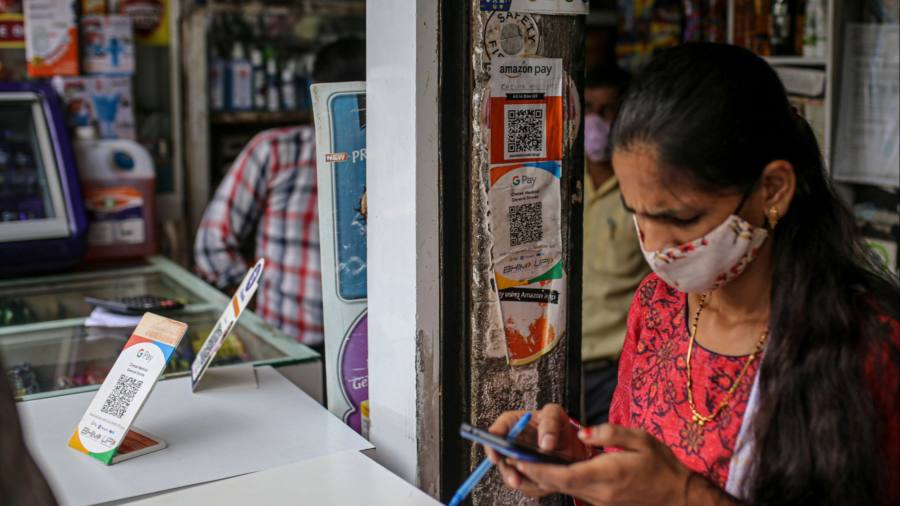Receive free Indian business & finance updates
We’ll send you a myFT Daily Digest email rounding up the latest Indian business & finance news every morning.
When Narendra Modi proclaimed “the dawn of the new India” last week, the prime minister was hailing his nation’s debut moon landing. But the pronouncement could equally have related to India’s growing confidence in the vanguard of financial innovation.
For years, Modi has pursued policies to push an overhaul of a financial system that not long ago was both old-fashioned and predominantly cash-based, as well as chaotic. This made fraud, bribery and tax evasion easy and endemic.
His 2016 decision to withdraw high-value notes from circulation with virtually no notice was contentious and caused huge disruption for many months. But combined with the development of a universal digital identity system (Aadhaar), and a push to develop a real-time digital finance architecture (UPI or Unified Payments Interface) on the back of it, there is little question that India’s financial system has been transformed.
A PwC report a couple of years after the demonetisation initiative concluded that both the number of taxpayers and direct tax collections had grown significantly, by 10 per cent and 19 per cent respectively. Instant payments of the kind facilitated by the low-cost UPI network have exploded. According to ACI Worldwide, India processed nearly 90bn transactions last year, more than anywhere in the world, and up 77 per cent on the year before. That dwarfs the likes of the US (2.8bn) and China (17.6bn). (On a per head basis, it ranks seventh, beating most developed countries, including the UK.)
The Aadhaar identity system that has provided the foundation for the UPI rollout has been criticised for further marginalising a minority of Indians. But 1.3bn Indians, including 99 per cent of adults, are now part of it. Dilip Asbe, who heads the National Payments Corporation, the organisation behind UPI, reckons 350mn people now use the system for payments, a number that should continue to expand as smartphone usage and 5G networks proliferate and services are extended to encompass credit and investments as well as payments.
To address those left behind, particularly in rural areas, India this month revealed an initiative to allow the processing of voice-based transactions. In areas with no or little internet connectivity, phone-to-phone transfers would be a viable alternative.
The UPI system has international potential too. Already real-time transfers using the network are feasible with Singapore, and the United Arab Emirates should create a similar link-up in the coming months, according to Asbe. Links to overseas locations where Indians live or travel could transform the efficiency and cost of remittances to family back home as well as boosting the tourism economy.
All this is only one leg of India’s digital finance transformation. The country has also been exploring the potential of a central bank digital currency (CBDC). This initiative that has been boosted by broader world events — the rise of China and Beijing’s ambitions for the renminbi; the challenge posed by upstart cryptocurrencies; and, perhaps, most of all by the weaponisation of the dollar and the global payment system by the US and its western allies as a means of punishing Russia’s invasion of Ukraine.
India is among the most advanced with its CBDC project. A pilot began late last year and has since been expanded to involve 13 banks in 26 locations, compared with four banks in four cities initially. Some experts believe a digital rupee might fully launch as soon as next year. The pilot project has involved integrating it with the UPI system, so that merchants can accept digital rupee payments using the same QR code they already have for UPI transactions.
Reformers believe a digital rupee offers a big opportunity to enhance the efficiency of both retail and wholesale payments. The international potential is significant, too, if the central bank can agree bilateral or multilateral swap arrangements with counterparts abroad.
At last week’s Brics summit, Brazil president Luiz Inácio Lula da Silva was pushing a new Brics currency. Even his fellow heads of state did not echo that call and no one expects the dollar to be undermined any time soon as the lingua franca of global money. But digital initiatives such as those in India, combined with stronger affiliations with countries uncomfortable with the primacy of the US currency, could well contribute to a gradual process of de-dollarisation and self-sufficiency among the world’s fastest-growing economies.
Read the full article here



